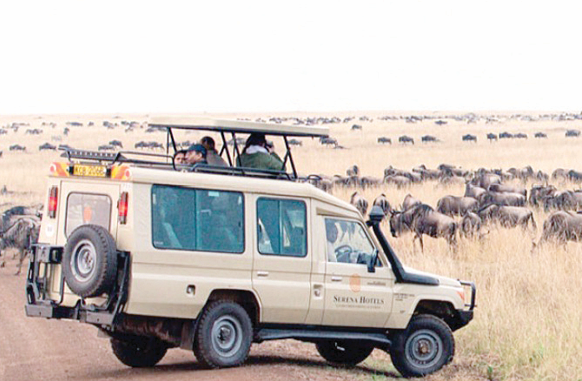Unlocking Kenya’s tourism potential: Growth and future opportunities
By Nicholas Waitathu, December 31, 2024The tourism industry witnessed robust growth, especially in hotel occupancies during the festive season, as domestic and international travellers continue to flock to various destinations across the country.
The high demand was confirmed by the Kenya Association of Hotelkeepers and Caterers (KAHC) Coast branch executive officer, Sam Ikwaye, who estiomated a 90 per cent occupation across key destinations such as Kisumu, Naivasha, Machakos, and the Coastal region.
Ikwaye attributed the success to curated experiences that cater to all budgets and preferences as hotels and resorts across the country devised packages tailored for a variety of clientele.
“Hotels have curated experiences to make this festive season enjoyable with diverse packages for all clients accommodating all budgets,” said Ikwaye.
Enhanced accessibility through improved road, rail, and air transport networks, coupled with robust security measures, further bolstered traveler confidence.
The coastal region, synonymous with leisure and tourism, has particularly thrived. Events such as the Mombasa International Festivals have played a significant role. Held at the Mama Ngina Waterfront grounds, these festivals showcased the cultural diversity of the coastal people, including their artifacts, cuisines, dances, and traditional attire.
According to Ikwaye, partnerships with stakeholders, such as the Mombasa Tourism Council, have enriched the region’s offerings. Highlights of the festive events included a swimming gala competition, food festivals, and boxing matches, all aimed at delivering a diverse and engaging experience.
This growth in tourism comes amid a 12.98 per cent increase in domestic tourism, with bed nights rising from 3,176,245 in 2023 to 3,588,568 in 2024, representing an addition of over 412,000.
Kenya Tourism Board (KTB) CEO June Chepkemei attributed this rise to innovative marketing campaigns and initiatives under the ‘Tembea Kenya’ umbrella. Notable among these was the ‘Tembea Kenya, Capture Magical Kenya’ photography competition, which encouraged Kenyans to explore and showcase hidden gems across the country’s 47 counties.
“It is clear that Kenyans are taking the initiative to travel more within their beautiful country. With festive seasons being peak travel periods, we have seen many creative ways that Kenyans have found to spend time with their loved ones and discover hidden gems that would otherwise go unnoticed,” said Chepkemei. She emphasized that such campaigns have been instrumental in promoting domestic tourism and unearthing Kenya’s rich cultural and natural heritage.
Despite these successes, unfortunately Kenya’s tourism sector competes with established global destinations such as South Africa, Morocco, and Thailand, which offer similar attractions but often at more competitive prices.
South Africa, for instance, has well-developed tourism infrastructure and aggressive marketing campaigns that draw international visitors.
Domestic and international travel in Kenya are expensive, with airfare, park entry fees, and accommodation costs being higher compared to neighboring countries like Tanzania or Rwanda. This limits accessibility for both local and foreign tourists.
Although the government has made significant strides in improving security, sporadic incidents of terrorism and general safety concerns continue to tarnish Kenya’s reputation as a safe travel destination.
Tourism has traditionally relied heavily on visitors from Europe and North America. This over-reliance makes the sector vulnerable to economic downturns or geopolitical issues in these regions.
Promote tourism products
Natural attractions, such as wildlife and beaches, are under threat from climate change, pollution, and habitat destruction. For instance, the degradation of coral reefs along the coast affects marine tourism, while poaching continues to pose risks to wildlife.
Kenya should intensify efforts to attract tourists from emerging markets such as China, India, and the Middle East. By developing niche tourism products like eco-tourism, adventure tourism, and cultural tourism, Kenya can tap into specific markets. For example, hiking in the Aberdare Ranges or cultural experiences in Turkana could attract a different set of travelers.
Continued investment in transport and hospitality infrastructure is essential. Projects like the Standard Gauge Railway (SGR) have already improved accessibility, but more needs to be done to connect remote yet beautiful destinations.
Collaborations between government bodies and private entities can help develop and promote tourism products. Events such as the Mombasa International Festivals exemplify the success of such partnerships.
Reviewing park fees, airfares, and accommodation taxes could make Kenya a more affordable destination. Competitive pricing is critical to attracting both domestic and international tourists.
Sustained efforts to ensure security in all tourist hotspots will be key in building confidence among travelers. This includes deploying specialized tourism police units and improving intelligence gathering.
Experts reckon that by addressing the main challenges and implementing the strategies, Kenya’s tourism sector can achieve sustained growth and cement its position as a leading global travel destination.
